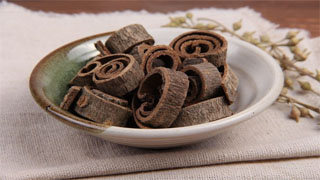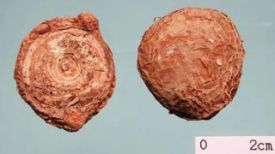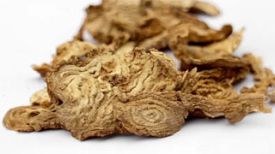
1. Alias
Thick skin, heavy skin, red bark, oil bark, Sichuan bark, purple oil bark.
2. Plant morphology
Deciduous trees. The bark is purple brown, the young branches are light yellow, and have silky hairs. Single leaves alternate, densely clustered at the top of small branches; The leaves are elliptical and ovate in shape, leathery in texture, with a blunt rounded or short pointed tip, a wedge-shaped base, and a whole or slightly wavy margin. The back is covered with gray white short hairs when young and becomes white powdery when old. Flowers and leaves bloom simultaneously, with solitary branches at the top, thick and short flower stalks, and hairy; Flower quilt slices 9-12, white, fragrant; The stamens and pistils are mostly arranged in a spiral pattern on the elongated receptacle. Aggregate fruit is long, oval shaped, and woody. Each room usually has one seed. The flowering period is from April to May, and the fruiting period is from September to October.
3. Origin distribution
Originating from Hubei, it is now widely cultivated.
4. Harvesting and processing
Peel from April to June, and dry the root bark and branch bark directly in the shade; After slightly boiling the dried skin in boiling water, stack it in a damp place and "sweat" until the inner surface turns purple brown or brown brown. Steam until soft and take it out, roll it into a cylindrical shape, and dry it.
5. Characteristics of medicinal herbs
Dry leather roll or double roll shape, commonly known as "drum pu"; One end of the dry skin near the root is spread out like a trumpet, commonly known as' simple boots'. The outer surface is gray brown or gray brown, rough, sometimes scaly, easy to peel off, with obvious oval skin holes and longitudinal wrinkles, and appears yellow brown when scraped off. The inner surface is purple brown or dark purple brown, relatively smooth, with fine longitudinal lines and visible oil marks when scratched. Hard in texture, not easy to break, granular in cross-section, outer layer gray brown, inner layer purple brown or brown, oily, some visible with many small bright stars. Fragrant aroma, spicy taste, slightly bitter. Some of the root bark (root bark) curves like chicken intestines, commonly known as "chicken intestine bark". Branch bark (branch bark) is single tube shaped, brittle in texture, easy to break, and fibrous in cross-section.
6. Sexual Taste Returning to the Classics
Warm in nature, bitter and pungent in taste. The Spleen Meridian, Stomach Meridian, Lung Meridian, and Large Intestine Meridian.
7. Effect and Function
Dry dampness, eliminate phlegm, and eliminate excess qi. It belongs to the category of dampness dispelling medicine.
8. Clinical application
Take 3-9 grams and decoct in water. Used to treat dampness stagnation injury, vomiting and diarrhea in the epigastric region, food accumulation and qi stagnation, abdominal distension and constipation, phlegm and thirst, wheezing and cough.
9. Pharmacological research
Has a muscle relaxation effect; Low doses stimulate intestinal smooth muscle, while high doses have inhibitory effects; Has anti ulcer effects, significant central inhibitory effects, lowers blood pressure, resists pathogenic microorganisms, and has anti-tumor properties; It also has antiplatelet and intracellular calcium flow inhibition effects.
10. Chemical composition
Containing volatile oils, alkaloids, saponins, as well as tannins and trace amounts of niacin. Containing components such as honokiol, camptothecin, syringaresinol-4 '- O - β - D-glucopyranose, camptothecin A, camptothecin B, camptothecin C, camptothecin D, camptothecin E, camptothecin F, camptothecin G, camptothecin H, camptothecin I, and camptothecin.
11. Usage taboos
Use with caution in patients with Qi deficiency, fluid damage and blood stasis, and pregnant women.
12. Compatibility prescription
① Treating insect accumulation: 6 grams each of Magnolia officinalis and Betel nut, 2 black plums, decoct in water and take orally. (Baochi Quanshu)
② To treat heart and spleen disorders, weak kidney qi, or cloudy stool and urine: 30g of Magnolia officinalis (made from ginger juice, stir fried) and 3g of Poria cocos. Take one serving of Luo evenly, one bowl of water and one bowl of wine, and fry until one bowl is served. Divide into two servings, warm before meals. (Pu Ji Fang Ying Quan San)
③ For patients with abdominal pain and constipation: 240g of Magnolia officinalis, 120g of Rheum palmatum, and five pieces of Fructus Aurantii. Add three flavors, take two liters of water per bucket, boil two flavors first, take five liters, and boil three liters of rhubarb inside. Warm clothing is one liter, with profit as the measure. ("Synopsis of Jin Kui" Houpu San Wu Tang)
④ To treat children's vomiting, diarrhea, stomach deficiency, and phlegm shock: 30g of Magnolia officinalis and 3g of Pinellia ternata (soaked seven times, soaked in ginger juice for half a day, dried in the sun). Soak three liters of rice swill together for a hundred quarters, and use all the water as a measure. If not, add less heat and boil dry, remove the Magnolia officinalis, only grind the Pinellia ternata. Take 1.5 grams per serving and adjust to mint soup. ("Direct Formula for Pediatric Medicine Syndrome" Houpu Powder)
⑤ Treating stomach deficiency and diarrhea, especially effective for elderly patients with visceral diarrhea: 0.9 grams of Aconitum (roasted), 0.3 grams of Magnolia officinalis (ginger roasted), 0.3 grams of Licorice (roasted), and 0.3 grams of dried ginger (roasted) each. Take 3 grams per serving, mix water three times, take 2 slices of ginger, and fry until two times. Hot take and stop taking two doses. (Su Shen Liang Fang "Jianpi San)
⊙ The content of the article is for clinical reference only. Non TCM professionals are not allowed to test drugs.


